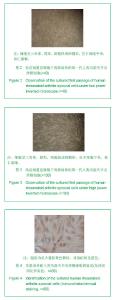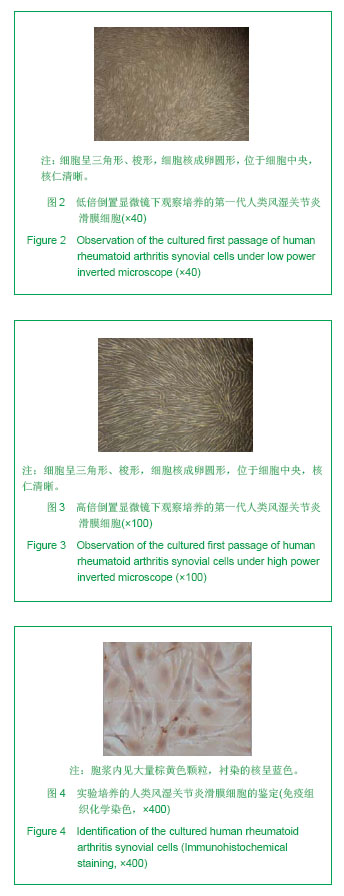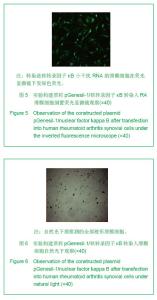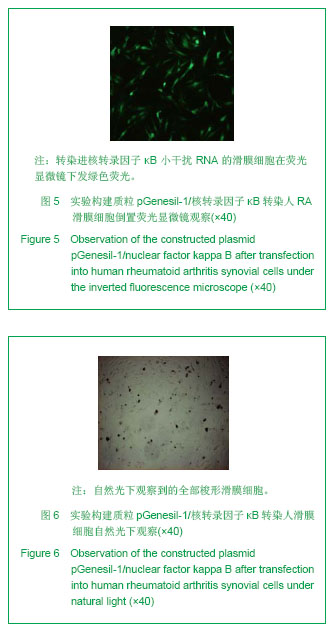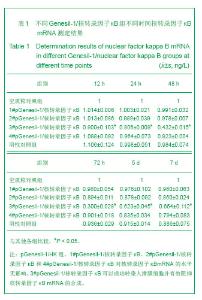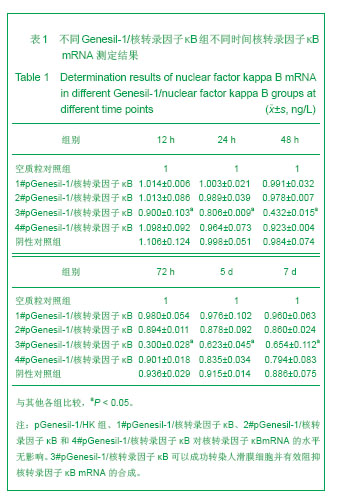| [1]Sioud M,Mellbye O,Forre O. Analysis of the NF-κB p65 subunit,Fas antigen,Gas ligand and Bcl-2-related proteins in the synovium of RA and polyarticular JRA. Clin Exp Rheumatol. 1998;16(2):125-134.
[2]Pinkenburg O, Platz J, Beisswenger C, et al. Inhibition of NF-kappaB mediated inflammation by siRNA expressed by recombinant adeno-associated virus. J Virol Methods. 2004; 120(1):119-122.
[3]Philippe L, Alsaleh G, Suffert G, et al. TLR2 expression is regulated by microRNA miR-19 in rheumatoid fibroblast-like synoviocytes. J Immunol. 2012;188(1):454-461.
[4]Bottini N, Firestein GS. Duality of fibroblast-like synoviocytes in RA: passive responders and imprinted aggressors.Nat Rev Rheumatol. 2013;9(1):24-33.
[5]Hannon GJ. RNA interference. Nature.2002; 418(6894): 244-251.
[6]Fire A,Xu S,Montogonmry MK,et al.Potent and specific genetic interference by double-stranded RNA in Caenorhabditis elegans.Nature. 1998;39l(6669):806-8l1.
[7]Buchan G,Barrett R,Tuner M,et al.Interleukin-1 and tumor necrosis factor mRNA epression in rheumatoid arthritis: prolonged production of IL-1 alpha. J Immunol. 2000; 164(3): 1576-1581.
[8]Ito H, Yamada H, Shibata TN, et al.Dual role of interleukin-17 in pannus growth and osteoclastogenesis in rheumatoid arthritis. Arthritis Res Ther. 2011;13(1):R14.
[9]Mimata Y,Kamataki A,Oikawa S,et al.Interleukin-6 upregulates expression of ADAMTS-4 in fibroblast-like synoviocytes from patients with rheumatoid arthritis. Int J Rheum Dis.2012;15(1):36-44.
[10]Murakami M, Hirano T.The pathological and physiological roles of IL-6 amplifier activation.Int J Biol Sci.2012;8(9): 1267-1280.
[11]Ward PA. Immunosuppression in sepsis. JAMA. 2011;306(23): 2618-1629.
[12]Angus DC. The search for effective therapy for sepsis: back to the drawingboard?.JAMA. 2011;306(23):2614-2615.
[13]Trenkmann M, Brock M, Gay RE ,et al. Tumor necrosis factor α-induced microRNA-18a activates rheumatoid arthritis synovial fibroblasts through a feedback loop in NF-κB signaling. Arthritis Rheum. 2013;65(4):916-927.
[14]Nah SS, Won HJ, Ha E, et al. Epidermal growth factor increases prostaglandin E2 production via ERK1 /2 MAPK and NF-κB pathway in fibroblast like synoviocytes from patients with rheumatoid arthritis.Rheumatol Int. 2010;30(4): 443-449.
[15]徐波,邢丞,李敏,等.醛肽类蛋白酶体抑制剂对LPS诱导小鼠巨噬细胞炎症介质表达的影响[J].中国病理生理杂志,2009,25(5): 988-992.
[16]Li G, Zhang Y, Qian Y, et al.Interleukin-17A promotes rheumatoid arthritis synoviocytes migration and invasion under hypoxia by increasing MMP2 and MMP9 expression through NF-κB/HIF-1α pathway. Mol Immunol.2013;53(3): 227-236.
[17]Lee YR, Kweon SH, Kwon KB, et al. Inhibition of IL-1beta-mediated inflammatory responses by the IkappaB alpha super-repressor in human fibroblast-like synoviocytes.Biochem Biophys Res Commun. 2009;278(1): 90-94.
[18]Roman-Blas JA, Jimenez SA. NF-kappaB as a potential therapeutic target in osteoarthritis and rheumatoid arthritis. Osteoarthritis Cartilage. 2006;14(9):839-848.
[19]秦明明,钱龙,汪国生,等. 类风湿关节炎患者造血干/祖细胞核因子κB1、κB2 基因表达的研究[J].免疫学杂志,2011,27(9): 789-793.
[20]Rahman MU, Buchanan J,Doyle MK,et al.Changes in patient characteristics in anti-tumour necrosis factor clinical trials for rheumatoid arthritis: results of an analysis of the literature over the past 16 years. Ann Rheum Dis. 2011;70(9): 1631-1640.
[21]Tiscornia G, Tergaonkar V, Galimi F, et al.CRE recombinase-inducible RNA interference mediated by lentiviral vectors.Proc Natl Acad Sci. 2004;101(19): 7347-7351.
[22]Aradhya S,Nelson DL.NF-kappaB signaling and human disease.Curr Opin Genet Dev.2001;11(3): 300-306.
[23]Tak PP,Firestein GS.NF-kappa B:a key role in inflammatory diseases.J Invest. 2001;107(1):7-11.
[24]Baldwin AS JR.Series introduction:the transcription factor NF-kappa B and human disease.J Clin Invest. 2001;107(1): 3-6.
[25]McCall P, Bennett L, Ahmad I, et al.NFκB signalling is upregulated in a subset of castrate-resistant prostate cancer patients and correlates with disease progression. Br J Cancer. 2012;107(9):1554-1563.
[26]Aggarwal BB, Takada Y, Shishodia S, et al. Nuclear transcription factor NF-kappa B: role in biology and medicine. Indian J Exp Biol. 2004;42(4):341-353.
[27]Li G, Liu D, Zhang Y, et al. Celastrol Inhibits Lipopolysaccharide-Stimulated Rheumatoid Fibroblast-Like Synoviocyte Invasion through Suppression of TLR4/NF-κB-Mediated Matrix Metalloproteinase-9 Expression. PLoS One. 2013;8(7):e68905.
[28]Li GQ, Zhang Y, Liu D, et al.Celastrol inhibits interleukin-17A-stimulated rheumatoid fibroblast-like synoviocyte migration and invasion through suppression of NF-κB-mediated matrix metalloproteinase-9 expression. Int Immunopharmacol. 2012;14(4):422-431.
[29]Marotte H, Tsou PS, Rabquer BJ,et al.Blocking of interferon regulatory factor1 reduces tumor necrosis factorα induced interleukin-18 bioactivity in rheumatoid arthritis synovial fibroblasts by induction of interleukin -18 binding protein a: role of the nuclear interferon regulatory factor 1-NF-κB-c-jun complex. 2011; 63(11):3253-3262.
[30]侯春凤,梁宏达,王吉波. 核转录因子κB和类风湿关节炎[J]. 中国组织工程研究与临床康复,2008,12(7):1304-1308.
[31]Epinat JC,Gilmore TD.Diverse agents act at multiple levels to inhibit the Rel/NF-κB signal transduction pathway.Oncogene. 1999;18:6896-6909.
[32]曾臻,潘发明,段振华,等. FCRL3基因rs7522061位点多态性与类风湿性关节炎遗传易感性的关系[J]. 安徽医科大学学报, 2012,47(2):206-208.
[33]蒋学峰,廖国玲,杨华,等. NRAMP1基因多态性与类风湿性关节炎遗传易感性的关联性研究[J].长治医学院学报,2011,25(6): 411-414.
[34]崔刘福,袁伟,杨文浩,等. 肽酰基精氨酸脱亚胺酶4基因多态性与类风湿性关节炎及抗环瓜氨酸化蛋白抗体的相关性研究[J]. 中国中医基础医学杂志,2011,17(6):630-632.
[35]Hetland ML.Modern treatment strategies in rheumatoid arthritis. Dan Med Bull. 2011;58(11):B4320.
[36]Bakhtiyari S, Haghani K, Basati G, et al. SiRNA therapeutics in the treatment of diseases. Ther Deliv. 2013;4(1):45-57.
[37]李博,胡秋侠,钟贵芳,等. 肿瘤坏死因子-α基因-238位点单核苷酸多态性与Infliximab治疗类风湿性关节炎疗效的相关性[J]. 广东医学,2012,33(24):3741-3744.
[38]Brummelkamp TR,Bernards R,Agami R,et al.Stable suppression of tumorigenicity by virus-mediated RNA interference.Cancer Cell. 2002;2(3):243-247.
[39]Wilda M,Fuchs U,Wossmann W,et al.Killing of leukemic cells with a BCR/ABL fusion gene by RNA interference(RNAi).Oncogene. 2002;21(37):5716-5724.
[40]Song E, Lee SK, Wang J, et al. RNA interference targeting Fas protects mice from fulminant hepatitis. Nat Med. 2003; 9(3):347-351.
[41]Jacque JM, Triques K, Stevenson M. Modulation of HIV-1 replication by RNA interference. Nature. 2002;418(6896): 435-438.
[42]陈巧林,李茹,张翠华,等. 小分子干扰RNA对人类白细胞抗原DRβ1^* 0401基因表达的抑制作用[J]. 中华医学杂志,2005, 85(22): 1568-1570.
[43]姜林娣. RNA干扰抑制COX-2合成以及对类风湿关节炎滑成纤维细胞生物学活性的影响研究[D]. 复旦大学,2006.
[44]荀春华,胡志坚,韩峰,等. 类风湿性关节炎患者microRNA-146a的表达及与血清学指标的相关性[J]. 细胞与分子免疫学杂志, 2013,29(5):529-530.
[45]兰忠煜,白希壮,韩晓锐,等. TAK1 siRNA对类风湿性关节炎患者滑膜细胞中mmp9和timp1表达的影响[J]. 中国医科大学学报, 2012,41(6):540-543. |
